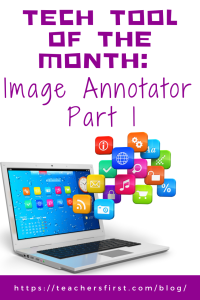Image Annotator is one of the many free tools found at classtools.net. Image Annotator allows users to add virtual hotspots to images they’ve uploaded. These hot spots are clickable dots. A title, description, and URL (such as a video link) can be shared when you click on the dot. Users click to add as many hot spots as they want. When finished, you are provided with a shareable link. In addition, you can also find an embed code you can use to share on your website. Finally, students can create annotated images and share the pictures with classmates using the provided URL. Please note that the Image Annotator does require a password when finished before you are provided with the shareable URL.
Applying the Triple E Framework
The Triple E Framework, created by Dr. Liz Kolb, believes that “effective technology integration begins with good instructional strategies and not fancy tools” (tripleeframework.com). Dr. Kolb wrote a book on the topic, Learning First, Technology Second (ISTE, 2017), that lays out the three main uses for technology in education: to Engage, Enhance, or Extend learning goals. We can use this framework to decipher why we use specific classroom tools. Here is a rubric based on the Triple E Framework you can use to evaluate whether Image Annotator (or any other technology) is a good fit with your learning goals and whether you should use it in your lesson.
- Engage in learning goals: Image Annotator helps students move from passive to active learners by creating images with hot spots of additional information. Students are motivated to begin learning as Image Annotator allows them to explore hot spots on a teacher-created image or create and share their own annotated images.
- Enhance learning goals: Image Annotator creates paths for students to demonstrate their understanding of the learning goals in a way they cannot do without technology. For example, students can click and add hot spots with research information, web links, and more.
- Extend learning goals: Dr. Kolb describes extended learning as an opportunity for students to learn, connect, and collaborate outside the regular school day and bridge the school day and real-life experiences. This tool would work well on virtual learning days for students to annotate images independently. The finished photos can be shared with the teacher or other students using the provided URL.
SAMR Connection
The SAMR Model, by Dr. Ruben Puentedura, suggests that technology implementation has four levels. Therefore, we can use this model as a guideline to analyze how we use technology tools in the classroom. For example, using Image Annotator can be at the Substitution, Augmentation, and Modification levels. Let’s look at an example of an activity at each of these three levels: labeling the parts of an animal cell.
- Substitution: The substitution level is the most basic level of SAMR and refers to when technology acts as a direct substitute without any functional improvements. An easy example is if teachers upload an image of an animal cell and have students use Image Annotator to label the parts rather than write directly on a printed image.
- Augmentation: At the level of augmentation, the technology acts as a direct substitute and includes some functional improvements. Going back to the example of the activity to label an animal cell, students could move to the level of augmentation by adding a web link and notes in addition to the title/labels.
- Modification: The level of modification allows us to make (or modify) the activity into something more integrated with technology, meaning there is significant task redesign. The animal cell labeling activity could be moved to modification by having the students find video links to add to the image hot spots. These finished images could be shared as instructional items for use by other students.
Please take advantage of Part 2 of the Tech Tool of the Month: Image Annotator, where we’ll discuss using the tool and classroom ideas. In the meantime, let us know how you have used Image Annotator in your education setting in the comment section below.


